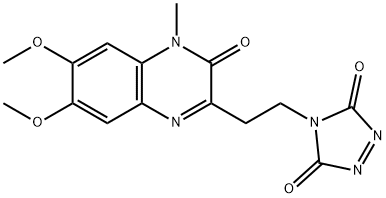4-METHYL-1,2,4-TRIAZOLINE-3,5-DIONE
- CAS NO.:13274-43-6
- Empirical Formula: C3H3N3O2
- Molecular Weight: 113.07
- MDL number: MFCD00013440
- SAFETY DATA SHEET (SDS)
- Update Date: 2023-04-23 13:52:06

What is 4-METHYL-1,2,4-TRIAZOLINE-3,5-DIONE?
The Uses of 4-METHYL-1,2,4-TRIAZOLINE-3,5-DIONE
4-METHYL-1,2,4-TRIAZOLINE-3,5-DIONE is a dienophile used in the partial elucidation of Trichogramma putative sex pheromone at trace levels.
Synthesis Reference(s)
The Journal of Organic Chemistry, 31, p. 3444, 1966 DOI: 10.1021/jo01348a532
Synthetic Communications, 17, p. 409, 1987 DOI: 10.1080/00397918708063918
Purification Methods
MTAD is obtained as pink needles by sublimation at 40-50o/0.1mm (see 4-phenyl-1,2,4-triazoline-3,5-dione, PTAD below). [Cookson et al. Org Synth 51 121 1971, Cheng et al. J Org Chem 49 2910 1984, Beilstein 26 III/IV 538.]
Properties of 4-METHYL-1,2,4-TRIAZOLINE-3,5-DIONE
| Melting point: | 107-109 °C(lit.) |
| Boiling point: | 137.5±23.0 °C(Predicted) |
| Density | 1.71±0.1 g/cm3(Predicted) |
| storage temp. | under inert gas (nitrogen or Argon) at 2-8°C |
| solubility | DMSO (Slightly), Chloroform (Sparingly), Ethyl Acetate (Slightly), Methanol |
| form | Solid |
| pka | -3.61±0.20(Predicted) |
| color | Pink to Dark Pink |
| Stability: | Hygroscopic, Temperature Sensitive, Unstable in Solution |
Safety information for 4-METHYL-1,2,4-TRIAZOLINE-3,5-DIONE
| Signal word | Warning |
| Pictogram(s) |
 Exclamation Mark Irritant GHS07 |
| GHS Hazard Statements |
H302:Acute toxicity,oral |
| Precautionary Statement Codes |
P280:Wear protective gloves/protective clothing/eye protection/face protection. P305+P351+P338:IF IN EYES: Rinse cautiously with water for several minutes. Remove contact lenses, if present and easy to do. Continuerinsing. |
Computed Descriptors for 4-METHYL-1,2,4-TRIAZOLINE-3,5-DIONE
New Products
Tert-butyl bis(2-chloroethyl)carbamate 4-Methylphenylacetic acid N-Boc-D-alaninol N-BOC-D/L-ALANINOL N-octanoyl benzotriazole 3-Morpholino-1-(4-nitrophenyl)-5,6-dihydropyridin- 2(1H)-one Furan-2,5-Dicarboxylic Acid DIETHYL AMINOMALONATE HYDROCHLORIDE 1,1’-CARBONYLDIIMIDAZOLE R-2-BENZYLOXY PROPIONIC ACID 1,1’-CARBONYLDI (1,2-4 TRIAZOLE) N-METHYL INDAZOLE-3-CARBOXYLIC ACID (2-Hydroxyphenyl)acetonitrile 4-Bromopyrazole 5-BROMO-2CYANO PYRIDINE 5,6-Dimethoxyindanone 5-broMo-2-chloro-N-cyclopentylpyriMidin-4-aMine 2-(Cyanocyclohexyl)acetic acid 4-methoxy-3,5-dinitropyridine 1-(4-(aminomethyl)benzyl)urea hydrochloride 2-aminopropyl benzoate hydrochloride diethyl 2-(2-((tertbutoxycarbonyl)amino) ethyl)malonate tert-butyl 4- (ureidomethyl)benzylcarbamate Ethyl-2-chloro((4-methoxyphenyl)hydrazono)acetateRelated products of tetrahydrofuran
![4-(4-METHOXY-PHENYL)-[1,2,4]TRIAZOLE-3,5-DIONE](https://img.chemicalbook.in/StructureFile/ChemBookStructure7/GIF/CB7421765.gif)
![4-(4-BROMO-PHENYL)-[1,2,4]TRIAZOLE-3,5-DIONE](https://img.chemicalbook.in/StructureFile/ChemBookStructure7/GIF/CB9100693.gif)

![4-(2-CHLORO-PHENYL)-[1,2,4]TRIAZOLE-3,5-DIONE](https://img.chemicalbook.in/StructureFile/ChemBookStructure9/GIF/CB5381452.gif)

![4-(4-CHLORO-PHENYL)-[1,2,4]TRIAZOLE-3,5-DIONE](https://img.chemicalbook.in/StructureFile/ChemBookStructure7/GIF/CB5700604.gif)

![4-P-TOLYL-[1,2,4]TRIAZOLE-3,5-DIONE](https://img.chemicalbook.in/StructureFile/ChemBookStructure2/GIF/CB0469724.gif)
You may like
-
 2033-24-1 98%View Details
2033-24-1 98%View Details
2033-24-1 -
 1975-50-4 98%View Details
1975-50-4 98%View Details
1975-50-4 -
 2-HYDROXY BENZYL ALCOHOL 98%View Details
2-HYDROXY BENZYL ALCOHOL 98%View Details
90-01-7 -
 2-Chloro-1,3-Bis(Dimethylamino)Trimethinium Hexafluorophosphate 221615-75-4 98%View Details
2-Chloro-1,3-Bis(Dimethylamino)Trimethinium Hexafluorophosphate 221615-75-4 98%View Details
221615-75-4 -
 61397-56-6 CIS BROMO BENZOATE 98%View Details
61397-56-6 CIS BROMO BENZOATE 98%View Details
61397-56-6 -
 14714-50-2 (2-Hydroxyphenyl)acetonitrile 98+View Details
14714-50-2 (2-Hydroxyphenyl)acetonitrile 98+View Details
14714-50-2 -
 118753-70-1 98+View Details
118753-70-1 98+View Details
118753-70-1 -
 733039-20-8 5-broMo-2-chloro-N-cyclopentylpyriMidin-4-aMine 98+View Details
733039-20-8 5-broMo-2-chloro-N-cyclopentylpyriMidin-4-aMine 98+View Details
733039-20-8
Statement: All products displayed on this website are only used for non medical purposes such as industrial applications or scientific research, and cannot be used for clinical diagnosis or treatment of humans or animals. They are not medicinal or edible.